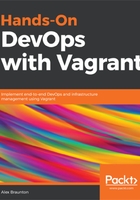
Understanding Vagrant
Vagrant is very simple on the surface, but is actually incredibly complex under the hood. It allows you to quickly and effortlessly create virtual environments (known as Vagrant boxes) and customize them. Vagrant easily integrates with multiple providers, such as VirtualBox, VMware, and Docker. These providers actually power the virtual environments, but Vagrant provides a customizable API to that virtual machine.
Vagrant has a large selection of commands, which can be used from the command line/Terminal to manage virtual environments. These commands can quickly download and set up an environment from the Vagrant cloud, which hosts many popular environments, such as Ubuntu or PHP's Laravel.
Vagrant is an important piece of software that can be found in many programmers' toolboxes. It is commonly used to tackle the well-known phrase, It works on my machine, by allowing everyone to have a copy of the same environment.
Vagrant was created by Mitchell Hashimoto and released in March 2010. Vagrant is now part of the HashiCorp company, which Mitchell Hashimoto cofounded in 2012 with Armon Dadgar. Vagrant is an open source piece of software that has been built in the Ruby language. It is currently being licensed under the MIT license. Vagrant can be run on macOS, Windows, FreeBSD, and Linux.
Vagrant is essentially another layer in the virtualization stack. It acts as an easily programmable interface to control virtual environments. Vagrant relies on a provider, such as VirtualBox, to power these environments, but it can also configure providers so they work in harmony – an example would be Vagrant controlling how much memory (RAM) an environment has.